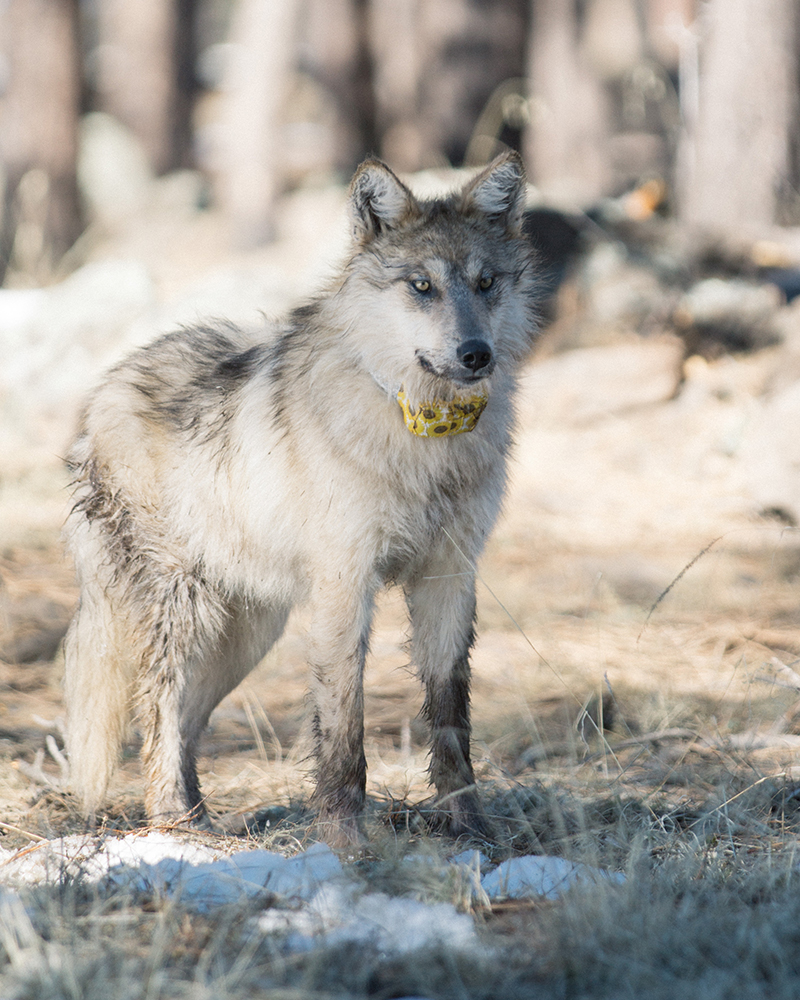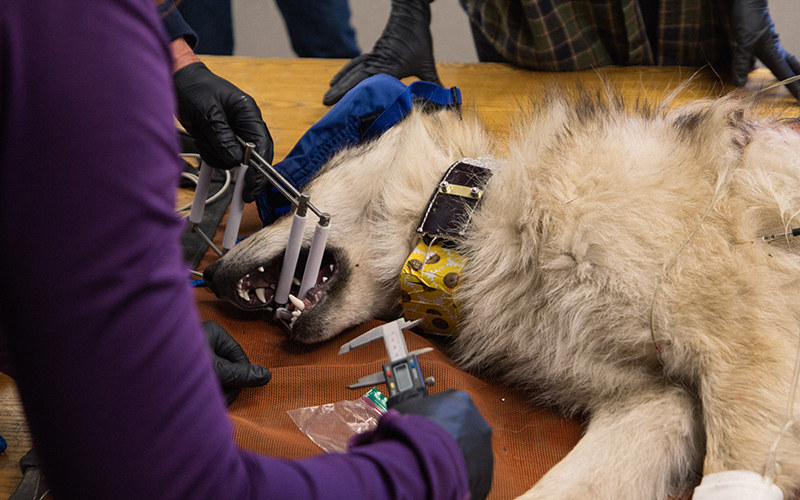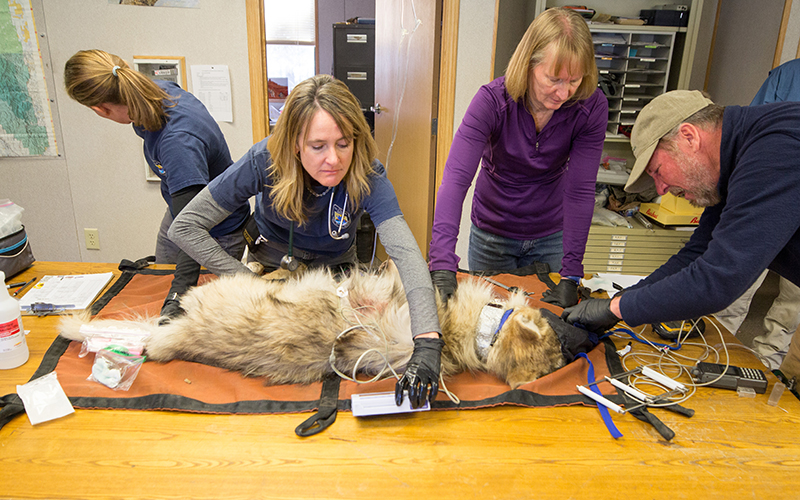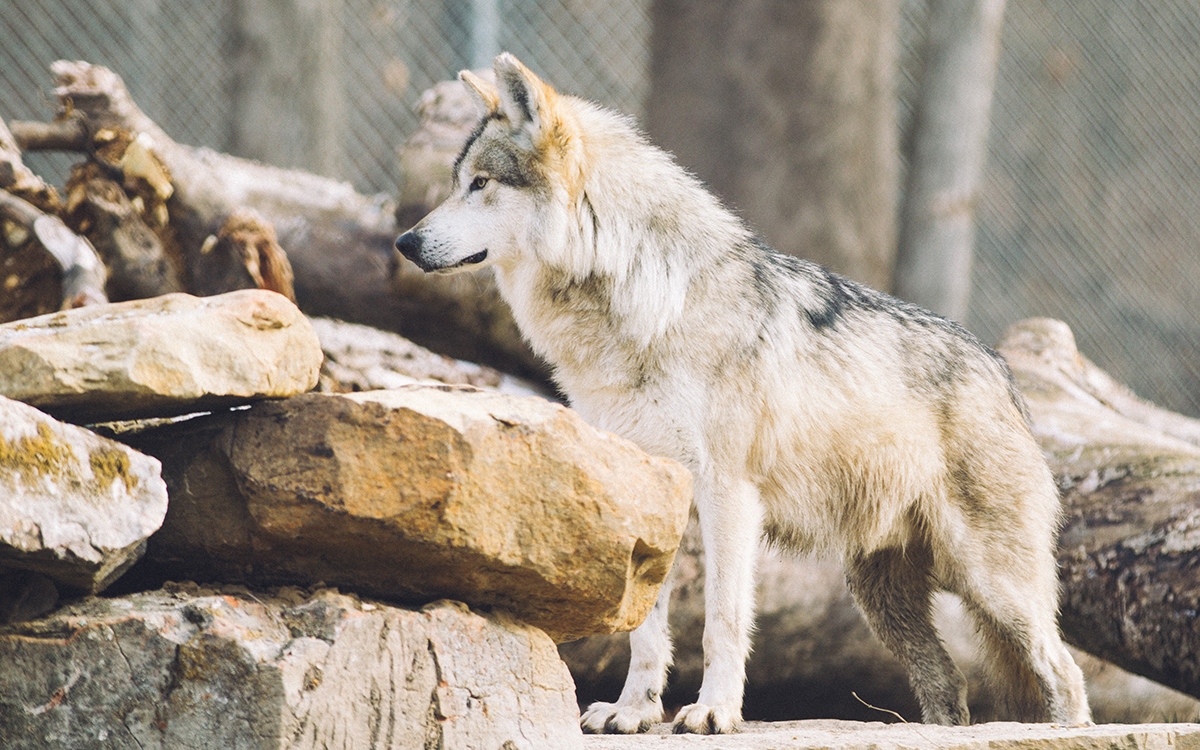
Wolf pup mp-1858 is seen after his release wearing the newly-placed tracking collar around his neck. (Photo by Michael Hannan/Cronkite News)
ALPINE – The day in late January began like any other for a Mexican wolf pup living in the spectacular solitude of eastern Arizona: searching for food with other wolves in the Apache National Forest.
Then came the terrifying chatter of a helicopter, a dash for cover, a jab in the rump – and a nap, courtesy of the sedative Telazol, delivered by dart gun.
After being transferred by helicopter to a remote location just outside Alpine, the 10-month old male was rushed into a warm, compact trailer where a team of biologists quickly analyzed him.
What they discovered thrilled them.
The capture of this wolf pup – later named mp-1858 – reaffirmed to the team that a decades-old, multistate, multiagency effort to help save the Mexican wolf population has made strides.
The biologists placed so much significance on mp-1858 because he was born in the wild, and he left his pack to tag along with a female and male Mexican wolf, possibly laying the foundation of a new pack.
The team has spent years placing new-born wolf pups in wild dens – a practice known as cross-fostering – but team members ultimately hope to see an increase in natural-born Mexican wolves, such as mp-1858, to help diversify the wolf population and raise its numbers.
Young mp-1858 was a rare find.
“We’ve got a pretty good handle on who’s who, but the individual we caught today is a little different,” said Maggie Dwire, deputy Mexican wolf recovery coordinator for the U.S. Fish and Wildlife Service. “We’re not sure why he was running with the group of wolves that he was with. So that kind of thing is really neat, right?”
Because mp-1858 was born in the wild, he’s exactly what those striving to boost the Mexican wolf population want to see.
Government agencies, including the Arizona Game & Fish Department, and the private Endangered Wolf Center in Missouri have invested millions of dollars and decades worth of research to save the Mexican wolf from extinction. Those efforts included breeding and releasing adult wolves into the wild, but that program has been placed on the back burner, replaced over the past six years by the cross-fostering program.
Every year, they team up to count wolves to evaluate their progress.
“The primary objective for this operation is to get a good count of the wolves that are out there,” said Genevieve Fuller, a wolf biologist with Arizona Game & Fish. “Secondary objective is to capture any animals that are deemed targets” – meaning any wolf found in a counting area.
To researchers, mp-1858 is a wolf that could symbolize the next phase of wolf rehabilitation.

Wolf pup mp-1858 is seen after his release wearing the newly-placed tracking collar around his neck. (Photo by Michael Hannan/Cronkite News)
Since its doors opened in 1971, the Endangered Wolf Center in Eureka, Missouri, has played a huge role in saving the Mexican wolf, through the release of captive-bred adults and cross-fostering pups into the wild.
Biologists traced mp-1858’s roots to the Endangered Wolf Center in Eureka, Missouri. Center officials said he likely is the offspring of adult wolves raised and released by the center or the offspring of cross-fostered wolves born in captivity and placed in dens by biologists.
The center has led the Mexican wolf cross-fostering program since it began in 2014. Founded almost 50 years ago, it sits on 63 isolated, wooded acres of a former military munitions area southwest of St. Louis, and is part of the Washington University Tyson Research Center. The center was constructed to match the cold, silent and humanless habitat where Mexican wolves live.
The center’s goal is to boost the genetic diversity and population of wolves through cross-fostering, in which 8- to 14-day-old pups born in captivity are placed in a den of similar-aged wild pups in remote areas of the Southwest.
“When we are looking at fostering pups to the wild, the captive program has a lot of different genetics than what the wild population has,” said Regina Mossotti, director of animal care and conservation at the Endangered Wolf Center. “So being able to take puppies from facilities like the Endangered Wolf Center and sneaking them into wild litters is a great way for us to be able to get new genetics out into the wild to help keep that wild population healthier.”
Mexican wolves breed in April and May, leaving a narrow window for cross-fostering.
“Fostering can be incredibly challenging in its own right,” Mossotti said. “The stars, the moon, the planets, everything has to align to make it happen.”
To successfully cross-foster a wolf pup, officials must identify a wild wolf that has given birth about the same time that a female wolf in captivity at the center gives birth.
When that does happen, the clock starts ticking.
“We have to be able to find a flight, the weather has to work and we have to have enough people to do it,” Mossotti said. “So all these things, these logistics have to come together to make it happen.”
Once the team from the Endangered Wolf Center arrives in Arizona, Game & Fish employees join them on a hike to a specific wolf den, often hidden in the rugged terrain along the Arizona-New Mexico state line.
The team carefully places the captive wolf pups, fitted with tracking collars, into the wild den and leaves them to their new lives.
Being part of the cross-fostering process “is so worth it,” Mossotti said. “To know that you’re helping release these puppies in the wild to give them that chance of freedom to help save a critically endangered species, there’s nothing better.”
In 1977, the Mexican wolf population in the U.S. was down to just seven. The center initially released adult Mexican wolves directly into the wild before adopting cross-fostering in 2014. Although the direct-release program was considered a success, biologists don’t plan to resume it unless absolutely necessary.
“We wouldn’t have the Mexican wolf program today if it (releasing adult wolves) didn’t work,” Mossotti said. “But you are releasing naive adults, and that can take them a little bit of time to get used to the area they’re in and to establish a territory.”
(Video by Dylan McKim/Cronkite News)
The Endangered Wolf Center opened its doors in 1971 when American zoologist Marlin Perkins and his wife, Carol, set out to address the endangerment of several species of wolves.
Virginia Busch, executive director of the Endangered Wolf Center, said wolves were a favorite animal of Perkins, the longtime host of TV’s “Wild Kingdom,” who died in 1986.
“We’re really proud that Marlin, even before the Endangered Species Act, had the forethought to build such an institution,” she said.
At the time of the center’s opening, the only captive Mexican wolves were being held at the Arizona-Sonora Desert Museum in Tucson. The only remaining captive female, Nina, was transferred to Missouri after failing to breed with any of the males.
In 1981, Nina mated with one of the last wild-caught wolves and gave birth to the first wolf pups conceived in captivity, according to the center.
“Our goal at the Endangered Wolf Center as well as through the species survival plan programs is to continue to breed those animals and have a healthy population,” Busch said. “For Mexican wolves, we are doing just that.”
As of 2020, Mexican wolf pups have been cross-fostered from centers across the country, including the Wolf Conservation Center in New York and the Sedgwick County Zoo in Wichita, Kansas.
Biologists in Arizona and New Mexico put boots on the ground to study wild Mexican wolves that live on both sides of the state line.
Nearly 1,250 miles west of the Endangered Wolf Center, the Apache National Forest in eastern Arizona is home to most of the wild Mexican wolves in the country.
In late January and early February, officials and biologists from Arizona Game & Fish in Alpine capture and examine wild Mexican wolves to gain more of an understanding of the current population and the progress of the cross-fostering program.
Game & Fish monitors 31 wolf packs by helicopter and tracking collars. This allows biologists to track the growth, location and progression of current packs while noting the creation of new packs.
“Since 2009, we’ve had an average annual increase of about 12%,” said Paul Greer, Mexican wolf interagency field team leader for Game & Fish. “The population has been cyclical up and down, but overall it’s an increasing population.”
Wolf biologists also have identified successes beyond the numbers. For example, biologists are seeing improvement of survival skills in cross-fostered wolves that they did not see in adult wolves that were released from captivity.
“So far, (cross-fostering) has been a better alternative to the release of adult wolves from captivity into the wild,” Fuller said. “We’re seeing a lot more wolves that understand how to be a wolf in this landscape because they were raised by wild parents.”
Although the cross-fostering efforts toward growing the Mexican wolf population have seen success, some critics of the program believe the process could be accelerated.
Sandy Bahr, director of the Sierra Club’s Grand Canyon Chapter, agreed cross-fostering has improved the Mexican wolf’s chances for survival, but she believes the introduction of captive adult wolves should resume.
“It (cross-fostering) can only be done on a pretty limited basis, because you have to have pups of the right age in the wild and in captivity,” Bahr said. “I agree that like a lone wolf might not be the best way to do it. That’s why we’ve really advocated for bonded packs. They’re much more likely to stay together. They can hunt together.”
Bahr said cross-fostering, in tandem with the release of adult wolves in packs, would increase the population more quickly than releasing adult wolves only.
“What (the Sierra Club) has said is release bonded packs, you know, release an alpha male and an alpha female,” Bahr said. “They’re much more likely to stay together, work together and survive versus what we’ve seen like with a lone wolf.”
Emily Renn, executive director of the Grand Canyon Wolf Recovery Plan, advocates for releasing adult wolves because they can add to the evolving genetic pool in a more immediate way.
“One of the things with the cross-fostered pups is it’s going to take at least two years before those wolves become adults and potentially become breeding wolves,” Renn said. “Obviously, it (releasing adult wolves) still needs a lot of consideration into how it’s done, but we want to see that included as an option.”
Although the recovery program has a long way to go before the biologist will call it a success, progress has been made by the steady increase in the Mexican wolf population.
Since the cross-fostering program began six years ago, Arizona Game & Fish has had success on multiple fronts.
In May, the field team conducted cross-fostering over six weeks, releasing 20 wolf pups in eastern Arizona and western New Mexico. In 2019, the team cross-fostered 12 wolf pups across western Arizona.
“It was a lucky year (2020),” said Jim deVos, Game & Fish assistant wildlife director. “It also took a tremendous amount of effort.”
According to the Mexican Recovery Wolf Program, about 50% of cross-fostered pups survive to reach prime breeding age.
The 2019 end-of-year census done by Game & Fish recorded the population of Mexican wolves had increased to 163 from 131. The department’s U.S. Southwest population goal is 320 wolves. The recovery plan also has set a goal for increasing the wolf population in Mexico to 200.
“Of the 12 wolves we released (in 2019), we’ve got four that have survived to breeding age and have already produced multiple litters of their own,” Greer said. “We’re seeing cross-fostered wolves surviving, breeding and producing multiple litters.”
Even with the success of the past few years, those close to Mexican wolf recovery programs aren’t quite satisfied.
“It’ll be nice one day if we can get the genetics up to where they need to be to be able to step back and let wolves be wolves,” Dwire said.

Inside the research trailer, wolf pups go through a series of examinations, including this one, which measures the size of the wolf’s mouth.

Maggie Dwire (far left), deputy Mexican wolf recovery coordinator for the U.S. Fish and Wildlife Service, and wolf biologist Ole Alcumbrac (far right) lead the team of biologists through their list of examinations. (Photos by Michael Hannan/Cronkite News)
Left: Inside the research trailer, wolf pups go through a series of examinations, including this one, which measures the size of the wolf’s mouth. Right: Maggie Dwire (far left), deputy Mexican wolf recovery coordinator for the U.S. Fish and Wildlife Service, and wolf biologist Ole Alcumbrac (far right) lead the team of biologists through their list of examinations. (Photos by Michael Hannan/Cronkite News)
Saving an entire species is not something that can be done for free, but with funding from the government and generous donations, it is possible.
Preserving an endangered species takes money.
In 2018, expenses ran about $1.5 million at the nonprofit Endangered Wolf Center, which is funded mostly through donations. To support its work, donors can pay to “adopt” a single wolf or an entire pack for a month or a year. The center also participates in classroom outreach, where biologists discuss how wild wolves survive and what can be done to save them from extinction. Schools and after-school programs are charged $150 to $350 per session.
As for Game & Fish, the department puts about 7% of its budget into wildlife conservation, according to its 2018 budget breakdown.
The Mexican wolf program also receives funding from the department’s Heritage Fund, which provides $10 million each year from Arizona lottery proceeds.

The Endangered Wolf Center in Eureka, Missouri, has served as the forefront of the Mexican wolf cross-fostering program since it began in 2014, playing host to many like the wolf pictured above. (Photo by Michael Hannan/Cronkite News)
There are more than 1,300 endangered species in the United States alone – what makes the Mexican wolf special?
More than 1,300 species in the U.S. are endangered or threatened and could use human help to avoid extinction. With so many plants and animals facing potential extinction, why save Mexican wolves specifically?
In fact, Mexican wolves have posed a threat to ranchers and livestock since Europeans first settled the Southwest. As the wolf population has edged up each year, so have ranchers’ anxieties.
However, Mossotti said, the Mexican wolf may play a bigger factor in the environment than seen at first glance. It’s classified as an “umbrella” species, she said, meaning the wolves affect a good portion of the ecosystem just by going about their business.
Mossotti compared the effect that the recovery of Mexican wolves has on the environment to a similar project the Endangered Wolf Center was a part of at Yellowstone National Park.
After scientists found no evidence of wolves in Yellowstone National Park for decades, the U.S. Fish and Wildlife Service began a wolf reintroduction program in 1995.
“When we released wolves in Yellowstone,” Mossotti said, “they had been extinct in the park for decades, and the park changed without them there. Elk population skyrocketed, deer population skyrocketed and they ate everything. They ate all the plants down to the dirt. When trees would fall, no new trees would replace them. Those trees and shrubs … provided habitat for birds and butterflies and lots of animals.”
Mossotti said the reintroduction of wolves to the park brought the elk and deer populations down to sustainable levels and allowed the plants to recover enough to provide for other animals that were suffering without them.
“To put all this energy into the wolf is ultimately to help make sure the ecosystem is healthier for everybody,” Mossotti said.